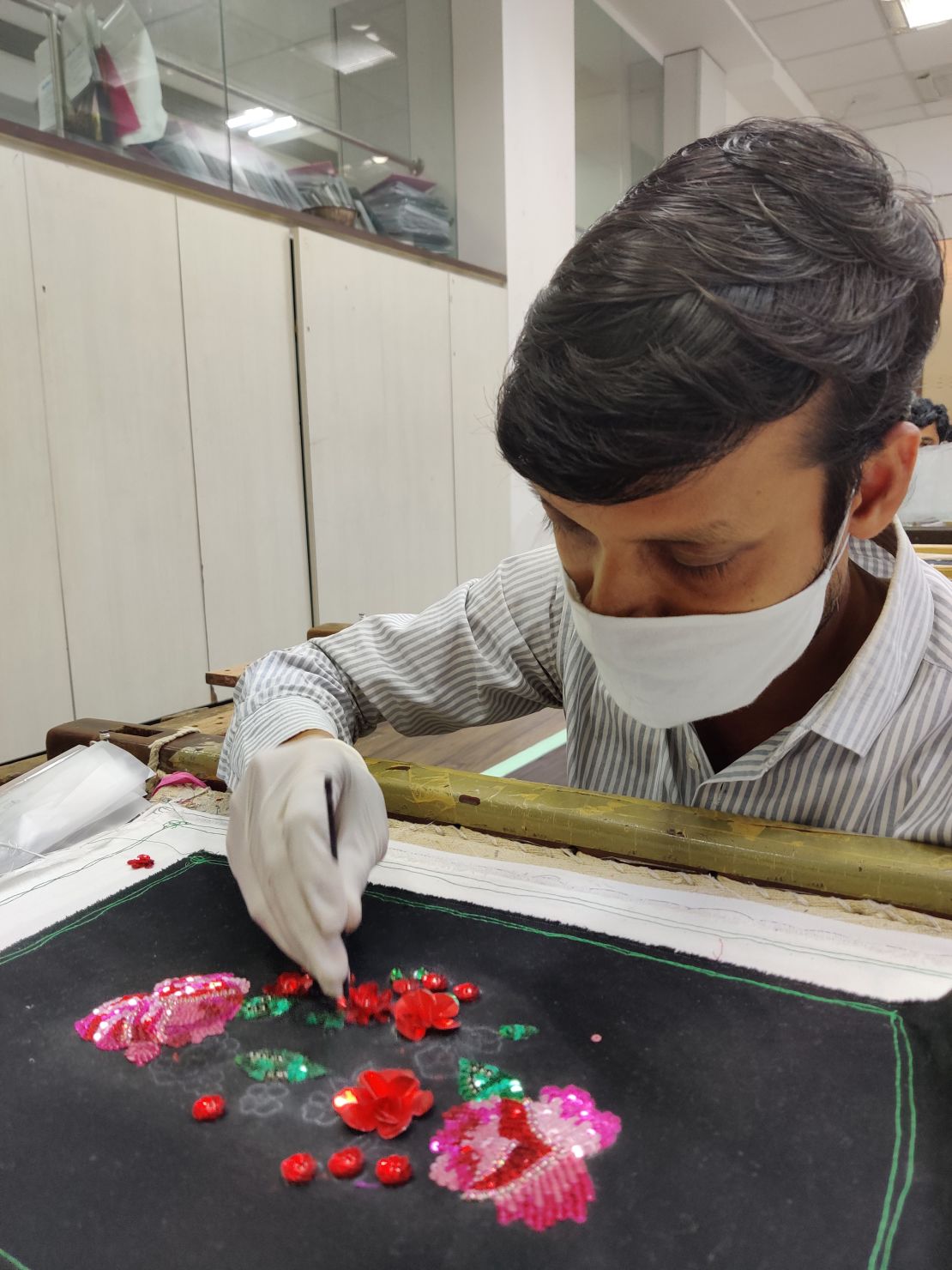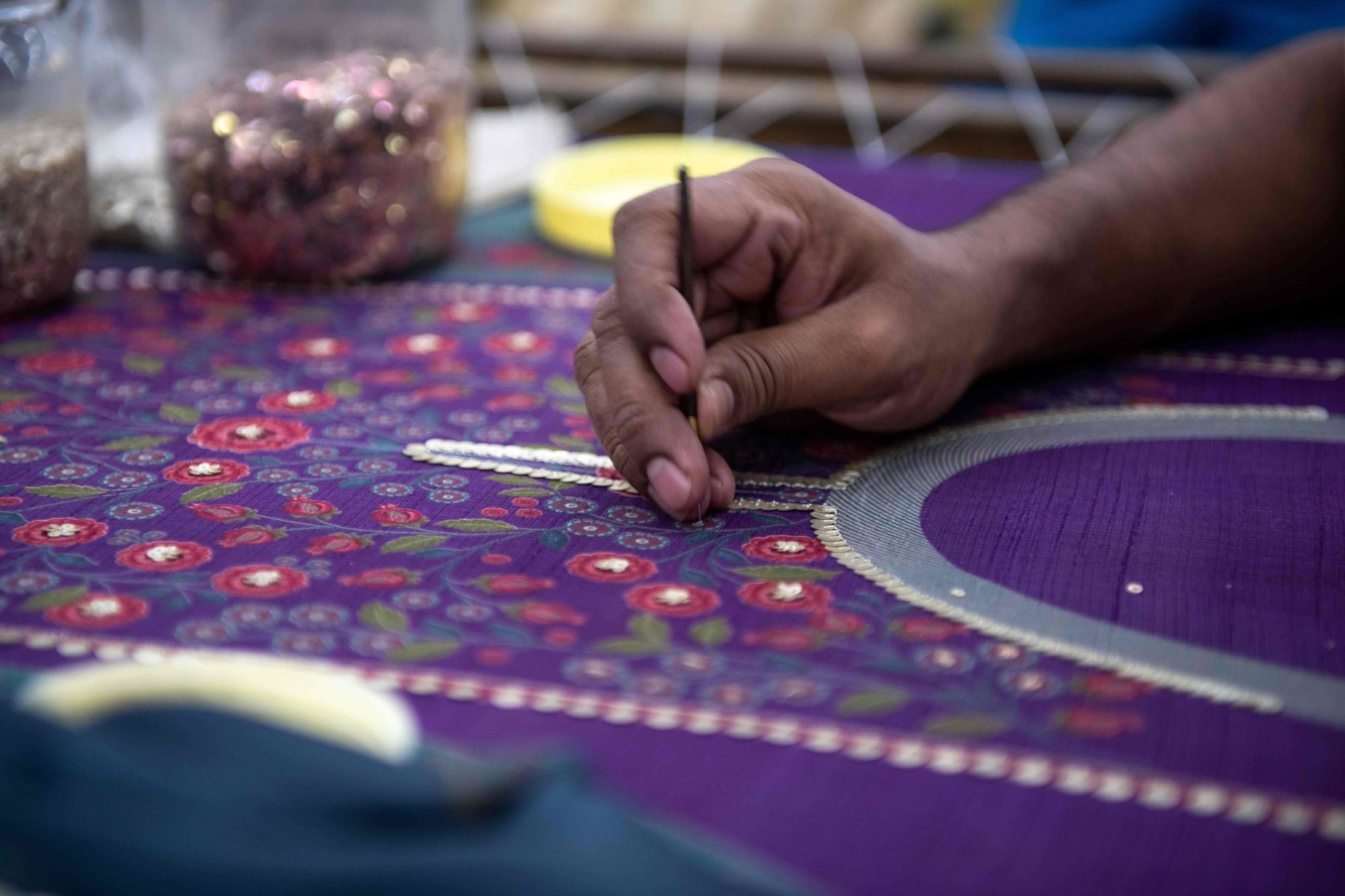Before the pandemic, Gayatri Khanna’s Mumbai-based embroidery firm used to work on luxury garments and accessories for some of the world’s biggest fashion houses.
Now, she said, some of them won’t even answer her calls.
“These are people who we have spoken to for years and years,” she said during a phone interview. “And suddenly there’s no news, or even a ‘What’s going on?’ Or, ‘How is the business?’”
Amid a coronavirus crisis that is pushing India’s hospitals to breaking point, collapsing demand for apparel in the West is also having a devastating knock-on effect on the country’s craftspeople. Luxury labels that have long depended on the intricate work of embroiderers and beading artists are scaling back production, leaving some suppliers unable to cover costs or pay workers.
Khanna, who is the founder and director of Milaaya Embroideries, said that her company’s export business is down 70% on the previous year. Though there were relatively few canceled orders at the very start of the pandemic, new work quickly dried up as labels gave their limited business to “one or two” core suppliers, she said.
The role of South Asian workshops in fast fashion is well documented. But Indian artisans also have an important hand in some of the world’s most expensive luxury items – including ready-to-wear collections and haute couture seen on red carpets and runways.
While this outsourcing is partly driven by the comparative cost of labor in Europe, artisans in India are especially sought-after for their skilled handiwork, which is often passed from generation to generation. Milaaya Embroideries, for instance, specializes in intricate styles of hand embroidery called “aari” and a technique called “zardozi,” which uses gold, silver and metallic threads.
The company makes everything from bridal wear to embroidered gowns, listing luxury brands like Givenchy, Gucci and Ralph Lauren as clients. And while Khanna did not point the finger at individual labels, she called on all her luxury clients to support the struggling artisans they depend on.
“The first thing they should do is they should consider those suppliers who are a vital part of their supply chain, like us – even if we were one of three, four or five suppliers – and see how they can continue to give us even a small amount of business,” she said.
“So I think a conversation should be had between the luxury brands and suppliers to say, ‘Hey, what can you do? What can we do?’”
LVMH, Kering (the parent companies of Givenchy and Gucci respectively) and Ralph Lauren did not respond to CNN’s request for comment on their business with Milaaya Embroideries or the current situation in India.
Industry in freefall
Milaaya Embroideries has been able to recoup some losses by producing face masks and launching a new retail brand that sells leisurewear and other everyday fashion items. Khanna said she continued paying 300 artisan employees, albeit with reduced salaries, throughout the pandemic – though there is little she can do for subcontractors or those who returned to their villages when India entered lockdown last year.
“We have been able to take care of them, but we can’t go on forever,” she said, predicting that, at the current rate, the company may only be able to support employees for another six months.

Many other garment workers have been less fortunate. The textile sector, which directly employs 45 million people and a further 60 million in associated industries, has been decimated by the pandemic.
During the country’s first wave, textile producers were the worst hit part of the manufacturing sector, according to the Centre for Monitoring Indian Economy. The think tank reported that the total wage bill of salaried textile workers – a measure of employment levels – dropped by 29% in the second quarter of 2020.
According to Shefalee Vasudev, editor-in-chief of the Indian fashion magazine Voice of Fashion, India’s lax labor laws have made it all too easy for manufacturers to cut artisans and craftspeople loose as business disappeared.
“Essentially, the millions of workers who work in the underbelly of the luxury industry … are non-contractual,” she said, adding: “If written contracts are in place, they often do not include the tenure of the work or whether somebody will get notice before being fired.”
Even if luxury houses wanted to support workers, their supply chains are often too convoluted for them to even know who crafts their garments, she added.
“You could have 500 people who do extremely dexterous and intricate embroidery, which will be then sold for thousands of dollars,” she said. “But when it lands on (a luxury label’s) creative director’s table, they may never know who did the work, because the first contractor has a subcontractor – there are these many invisible supply chains that come into play.”
No business as usual
Though India’s domestic Covid-19 situation worsens by the day, with almost 400,000 new cases recorded on Saturday alone, resumed consumption in other markets offers a glimmer of hope for the country’s beleaguered craftspeople. Kering and LVMH, parent companies to some of Europe’s biggest fashion houses, have both reported rebounding sales thanks in large part to returning shoppers in China and the US.
New demand should quickly translate into increased production in India, said Vasudev. But the editor, who has reported extensively on the impact of Covid-19 on Indian garment manufacturing, warned that the resumption of orders may not mean a return to pre-pandemic wages or conditions for workers.
“What I see happening is that, after the recovery, these people will be exploited (because employers will say): ‘This is a matter of survival for you. You were previously getting 50 rupees to do this, now do it for 25, because otherwise you’ll get nothing.’ So, I actually see the problems increasing in the next year.
“A number of (people working in manufacturing) have told me that they are telling people, ‘What are you asking for raises and promotions for? Don’t forget that you still have a job.’”
This article has been updated to clarify an interview quote.

